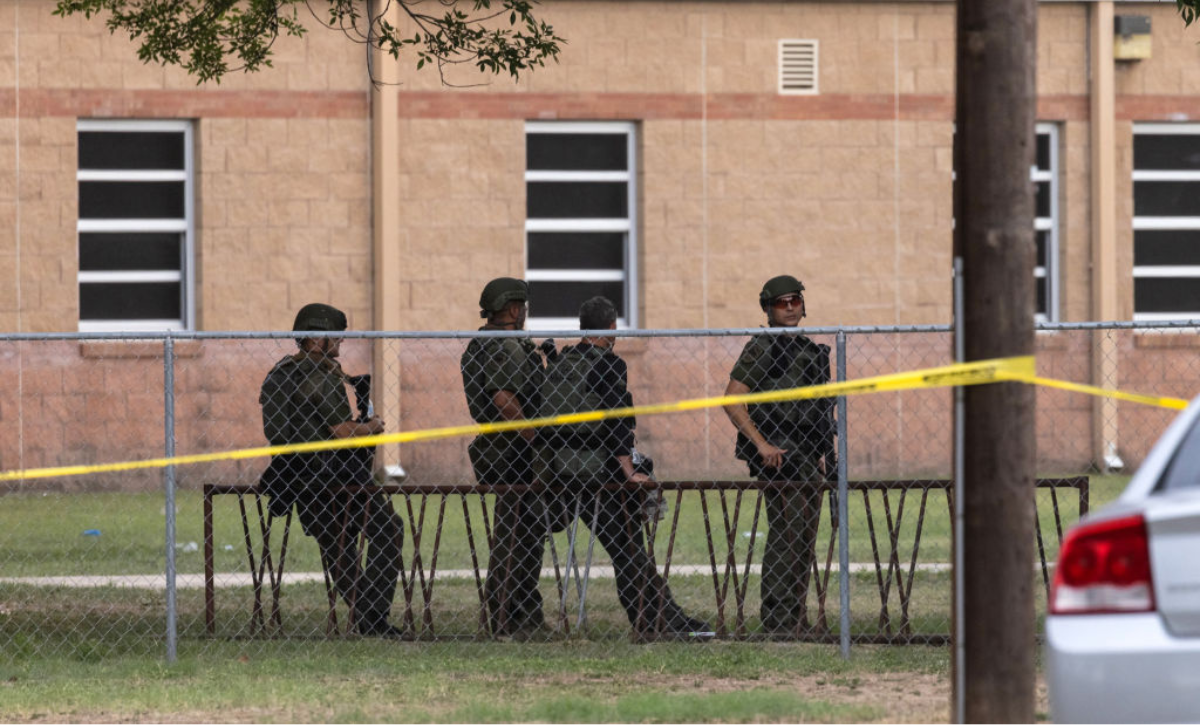School Chiefs’ POV: Arming Teachers & ‘Hardening’ Schools Reckless, Toxic Ideas
Three current and former district leaders say new proposals to harden classrooms could easily do more harm than good

Get stories like these delivered straight to your inbox. Sign up for The 74 Newsletter
All of America lost sleep last month as the horror of 19 children and two teachers being gunned down in an elementary school dominated the news cycle and filled social media with shock, outrage and grief.
In the ensuing days, cable news channels and social feeds have been full of diagnoses and remedies to this national sickness. Some solutions — such as common-sense and largely popular gun safety reforms, mental health supports and better protocols for emergency response — warrant urgent action.
But there is another set of supposed solutions that are unserious, uninformed and utterly reckless as they pertain to protecting the emotional, psychological and physical safety of students in school buildings. Worse, these irresponsible suggestions are finding their way into legislation, such as a new law in Ohio (where one of us leads the state’s second-largest school district) that directly encourages districts to staff schools with armed teachers and personnel.
For people like us — school system leaders and safety experts who have committed our lives to creating safe spaces for children every day — the tragedy in Uvalde, Texas, followed by a gunfight among teenagers on a crowded Philadelphia street that led to an educator’s death, reinforces the urgent need for more credible investments in the support and safety of young people — not more armed adults.
The evidence is clear: More guns in schools will simply mean more kids and adults being accidentally shot. Teachers aren’t trained in gun safety or even in how to use a gun in the unlikely event they happen to be in a position to use one in self-defense. We don’t want them to be. Can you imagine it? During professional development on Monday, we discuss the science of reading, and on Tuesday, where to shoot if a mass murderer is wearing body armor?
Further, in too many schools across America, implicit biases lead to the costly and inappropriate criminalization of student behavior, especially for Black students (who, incidentally, have not perpetrated a single mass school shooting). The consequences of these unexamined dynamics will be even deadlier for the most vulnerable students if teachers are encouraged to think of themselves as vigilantes rather than mentors and molders of young minds.
Similarly, calls to further “harden” school environments may appeal to a visceral instinct to shield children from harm, but they quickly unravel with dire unintended consequences under any reasonable scrutiny.
Having a single point of entry in and out of a school is dangerous. Obviously, students and staff might have multiple reasons to evacuate, including during gun emergencies. Instructing classroom teachers to lock their doors as a matter of practice is not viable — administrators need to see what’s happening in real time to give feedback, build relationships and build collective momentum for progress. Students need to get water and use the bathroom.
Moreover, many school buildings already lack basic infrastructure like mold-free cafeterias or even potable water. Are we seriously suggesting that they will now become impervious to military-grade weapons? And beyond the fatal practical flaws of these ideas, what about the profound psychological impact of turning schools into military-style fortresses?
It is not enough to argue against these destructive recommendations as though they were worthy of consideration. The mere injection of these ideas into the policy debate is a kind of toxicity, akin to the smog of disinformation that already chokes the country’s democratic process and prevents effective governance. These toxins must be eradicated and summarily dismissed out of hand.
But instead of extinguishing these ideas when when they spark, traditional and social media fan the flames, validating the pundits and politicians who offer up these ludicrous and deeply flawed policies. This quickly derails productive debate over the kinds of solutions our children and communities need. Productive debate is quickly derailed from the kinds of solutions America desperately needs (and which hold broad public support), while these dangerous ideas spread like wildfire through dry brush. Even attempts to extinguish the spread somehow confer validity onto ideas that should have fizzled from the start.
The nation has seen the implications of this vicious circle before. Throughout the COVID pandemic, too many news programs and social media apps gave platform to hucksters who downplayed the effects of the virus, cast doubt on highly effective vaccines and weakened public resolve to tackle a global health crisis. Some brave infectious disease and medical experts did what they could to break through with facts and evidence, but the damage was done.
Our country shouldn’t make the same mistake when it comes to the epidemic of gun violence. This moment of public outcry is an opportunity to enact real solutions that truly can lead to safer and healthier schools—including commonsense gun laws and investments in school infrastructure and mental health. Arming teachers and bringing more guns into schools are not solutions.
We implore every American — especially elected leaders and the media who give them lift — to consider the consequences of reckless and uninformed positions and focus on what it is actually possible to do to protect the nation’s children.
Cami Anderson has served as a public school superintendent in New York City and Newark, New Jersey. Eric S. Gordon has served as the chief executive officer of Cleveland Metropolitan School District in Ohio since 2011. Dr. William R. Hite has served since 2012 as Superintendent of The School District of Philadelphia, the largest public school system in Pennsylvania.
Get stories like these delivered straight to your inbox. Sign up for The 74 Newsletter

;)
